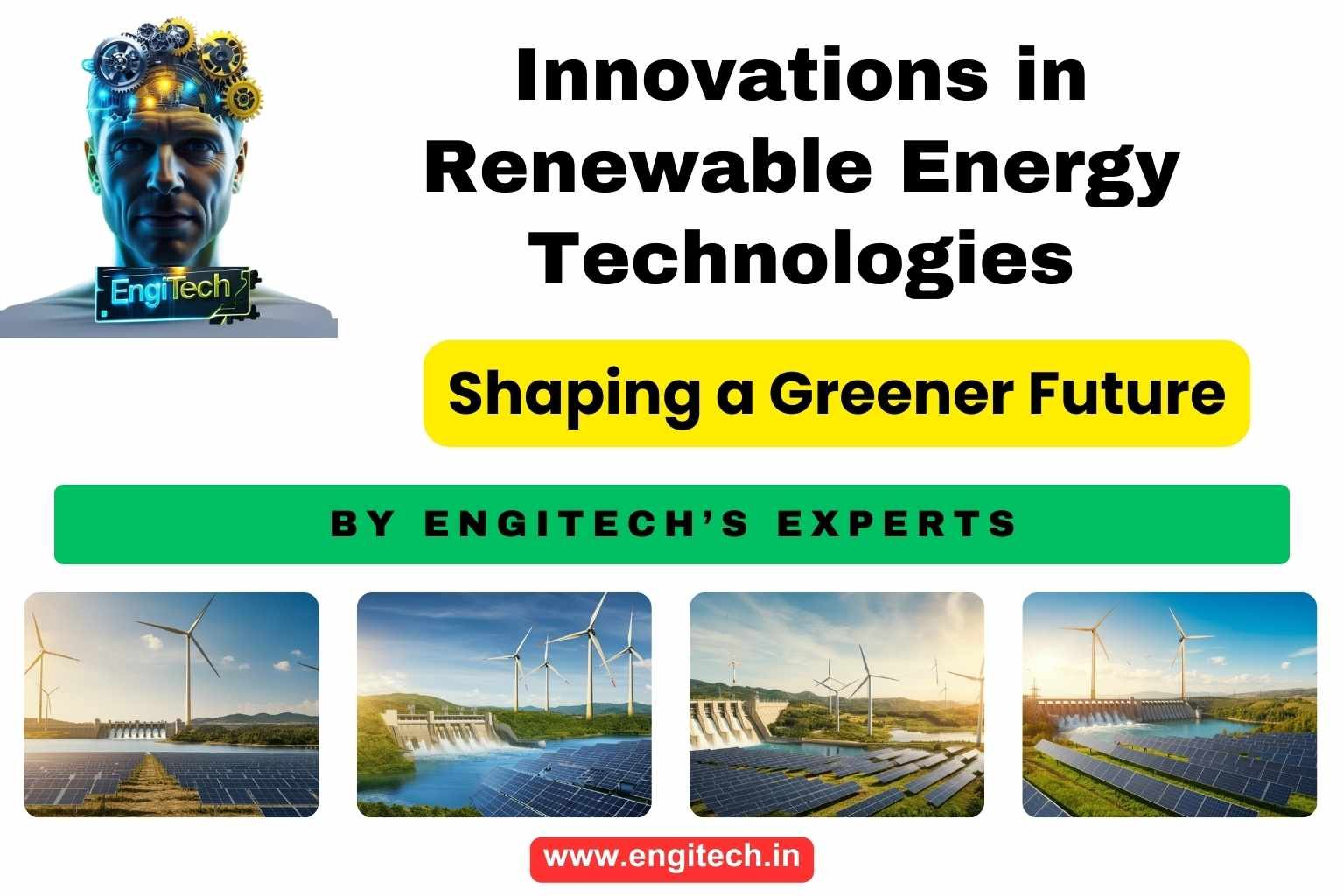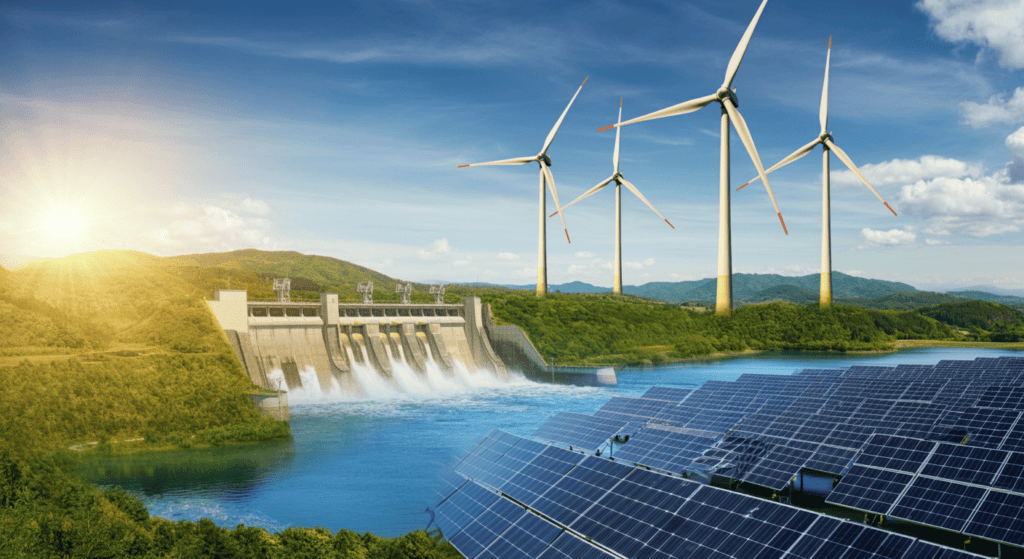Innovations in Renewable Energy Technologies: Shaping a Greener Future

The past decade has witnessed an unprecedented surge in public awareness about climate change, energy security, and the urgency of transitioning toward more sustainable sources of power. This global shift—catalyzed by growing evidence of environmental stress and supported by robust government policies—has placed Innovations in Renewable Energy Technologies at the forefront of worldwide discourse.
In this in-depth guide, we’ll explore the cutting-edge breakthroughs in renewable energy systems, discuss the role of innovative renewable engineering companies, and examine real-world examples of renewable projects that are redefining our collective future.
Whether you’re a curious individual seeking cleaner energy options, a policymaker drafting new directives, or a professional aiming to take part in the next big renewable energy project, this article will help you navigate the dynamic world of sustainable power. Keep reading to learn how different types of renewable energy—from solar and wind to RepowerEU biogas and Plasma Arc Gasification—are revolutionizing the way we produce electricity, manage waste, and safeguard our natural ecosystems for generations to come.
Table of Contents
The Growing Importance of Renewable Energy Systems
From Fossil Fuels to Clean Energy—A Paradigm Shift
Human civilization relied predominantly on coal, oil, and natural gas for well over a century. These fossil fuels sparked the Industrial Revolution, fueled technological progress, and improved the quality of life for billions. Yet, decades of scientific research now show that our heavy dependence on non-renewable resources is neither sustainable nor equitable in the long run. Greenhouse gas emissions have reached alarming levels, contributing to global warming, air pollution, and a host of environmental imbalances. Add in the volatility of fossil-fuel prices and the geopolitical tussles over resource access, and you have a strong incentive to move toward renewable projects that mitigate environmental damage and stabilize energy supplies.
The hallmark of a true paradigm shift isn’t merely acknowledging problems; it’s actively implementing solutions. And that’s precisely where innovations in renewable energy technologies come into play. Solar panels that once yielded meager efficiency now boast cutting-edge materials capable of harnessing more sunlight than ever. Wind turbines have grown taller and more efficient, capturing wind currents previously deemed unusable. With each breakthrough, we inch closer to a future in which clean energy is not a utopian ideal but an everyday reality.

Key Drivers Behind the Surge in Renewable Projects
- Environmental Urgency
Mounting concerns over climate change and pollution have spurred a massive rallying cry for cleaner energy sources. Public demand for sustainability, coupled with heightened awareness of climate challenges, urges governments and private entities alike to fund and adopt renewable energy systems. - Cost Competitiveness
Technological improvements and economies of scale have drastically reduced the costs of equipment like solar photovoltaic modules, wind turbine components, and energy storage devices. Many renewable projects are now cost-competitive with or even cheaper than traditional fossil-fuel power plants. - Policy Support and Incentives
Governments worldwide are rolling out incentives—feed-in tariffs, tax credits, grants, and renewable energy certificates—to encourage the uptake of renewables. These policies significantly lower financial barriers, making it easier for households and businesses to transition to sustainable power sources. - Corporate Commitments
Large corporations, including major tech firms, retailers, and manufacturers, are making pledges to operate on 100% renewable power. Such commitments not only reduce operational costs but also cater to environmentally conscious consumers who demand ethical practices. - Investment and Research
Venture capital firms, philanthropic foundations, and research organizations are injecting capital into emerging technologies, from advanced battery chemistries to innovative waste-to-energy solutions like Plasma Arc Gasification. This influx of funding accelerates the development of novel approaches that push the envelope of renewable energy’s potential.
Types of Renewable Energy: An In-Depth Exploration
Modern innovations in renewable energy technologies cover a vast array of energy sources, each with its unique characteristics, challenges, and advantages. Understanding the most prominent types of renewable energy is crucial for anyone interested in how these systems function and how they might evolve in the future.
Solar Power Innovations
Historical Context and Modern Breakthroughs
Solar energy—tapping the sun’s radiant power—has evolved from a niche concept into one of the fastest-growing renewable energy systems globally. Early photovoltaic (PV) cells had notably poor efficiency, hovering around a mere 4-5%. Today, commercial panels have surpassed 20% efficiency, and experimental labs have achieved even higher figures by using multilayer cells and cutting-edge materials.
- Perovskite Solar Cells
Among the most discussed breakthroughs in solar technology are perovskite-based solar cells. These compounds can be manufactured at lower costs and, when combined in tandem with silicon cells, exhibit higher overall efficiency. Researchers aim to overcome their sensitivity to moisture, which remains a key barrier to widespread commercial adoption. - Solar Thermophotovoltaics (STPV)
STPV systems use solar radiation to heat a material that then re-emits light at wavelengths optimal for photovoltaic conversion. This approach has the theoretical potential to exceed the efficiency limits of conventional single-junction cells. While still in the experimental stage, STPV could reshape how we harness the sun’s power. - Bifacial Panels and Solar Tracking
Innovations such as bifacial panels—designed to capture solar energy from both sides—and dual-axis solar tracking systems can significantly increase overall energy yield. While these technologies boost performance, they also add complexity and costs, making them more suitable for specific large-scale renewable energy project deployments.
Wind Energy Advancements
Offshore Wind Farms
Wind energy has become a mainstay in the renewable sector, second only to solar in terms of installed capacity in many regions. One significant trend is the migration offshore, where wind speeds tend to be stronger and more consistent. Offshore wind turbines, some towering over 700 feet tall, can generate immense power without the land-use constraints that onshore installations often face.
Floating Turbine Technologies
Coastal areas with deep waters are ideal for floating turbines. Engineered to float on massive platforms anchored to the seabed, these structures can harness powerful ocean winds without the complex infrastructure of traditional offshore wind farms. Countries like Norway and Portugal are pioneering commercial-scale floating wind projects.
Blade and Material Innovations
New materials such as carbon fiber and advanced composites create lighter, more aerodynamic blades. Some designs use segmented blades for easier transportation and installation. Enhanced blade aerodynamics also reduce noise pollution and bird collisions, addressing environmental and community concerns.
Hydroelectric Power: Old But Gold
Hydroelectric power is often considered the “original” renewable. Large dams across major rivers generate massive amounts of electricity by harnessing the kinetic energy of flowing water. Well-known mega-dams like the Three Gorges Dam in China can power entire regions. However, large-scale dam projects can significantly impact local ecosystems and displace communities.
Small-Scale and Run-of-River Systems
A growing movement toward smaller, decentralized hydro systems is garnering attention. Run-of-river installations minimize the need for large reservoirs, thereby reducing the environmental footprint. Advanced control systems and turbine designs are expanding the feasibility of small-scale hydro as part of broader renewable projects in remote or rural areas.
Biomass and RepowerEU Biogas: The Next Frontier
Biomass energy typically involves burning or fermenting organic materials—crop residues, wood chips, and other plant-based matter—to produce heat or electricity. Although combustion-based biomass can yield carbon emissions, it is often considered carbon-neutral if managed sustainably, because plants reabsorb CO₂ as they grow.
Anaerobic Digestion and Biogas
One major leap forward is the utilization of anaerobic digestion to break down organic waste into biogas. Under the umbrella of initiatives such as RepowerEU biogas, governments across Europe are bolstering the use of biogas by offering incentives and funding. This biogas can be cleaned and upgraded to biomethane, suitable for direct injection into natural gas grids.
Co-Digestion Innovations
Co-digestion—combining various types of organic waste—can improve the efficiency and stability of the digestion process. Farms, for instance, can mix livestock manure with food-processing waste. The synergy in these feedstocks often boosts overall gas yield, transforming what was once waste into a valuable source of renewable energy.
Plasma Arc Gasification: A High-Tech Approach to Waste and Bio-Fuel
While the term “plasma” may conjure images of futuristic science fiction, Plasma Arc Gasification is a real-world technology that uses extremely high temperatures—reaching thousands of degrees Celsius—to break down waste into its constituent molecular components. Unlike incineration, plasma gasification typically produces fewer toxins because harmful compounds are destroyed at very high temperatures.
- Versatility and Waste Management
Municipal solid waste, industrial byproducts, and even medical waste can be converted into synthetic gas (syngas) that can be used to generate electricity or transformed into fuels. This dual benefit of waste reduction and energy creation makes plasma arc gasification a valuable tool in the broader context of renewable energy systems. - Challenges and Cost Concerns
The technology is capital-intensive. Building and maintaining plasma reactors can be expensive, and the feedstock must be carefully prepared to maximize efficiency. Nonetheless, as technology matures and gains scale, the cost per kilowatt-hour is likely to become more competitive.
Geothermal Energy: Tapping the Earth’s Core
Geothermal energy, derived from heat trapped beneath the Earth’s surface, offers a consistent and often underutilized power supply. Traditional geothermal plants pump hot water or steam from underground reservoirs to drive turbines. Regions such as Iceland and parts of the United States (like the Geysers in California) are already capitalizing on this near-constant energy source.
Enhanced Geothermal Systems (EGS)
EGS involves artificially stimulating rock formations to enhance heat extraction. By drilling wells and injecting fluid into hot rock layers, engineers can create a reservoir where heat exchange is more efficient. EGS could unlock geothermal potential far beyond volcanic hotspots, bringing this form of baseload power to new territories.
Leading Renewable Engineering Companies and Their Innovations
Behind every large-scale renewable energy project stands an array of renewable engineering companies pushing boundaries and testing innovative solutions. From specialized solar startups to multinational power conglomerates, the expertise and cutting-edge research they bring to the table fuel the rapid growth and integration of renewable energy worldwide.
- Major Solar Firms
Industry leaders in solar PV technology are increasingly focused on manufacturing perovskite-silicon tandem cells. Some firms are also developing advanced storage solutions, offering one-stop-shop solutions for residential and commercial customers. - Wind Energy Giants
A handful of European and Chinese wind turbine manufacturers dominate the global market. These companies are investing in R&D to refine rotor aerodynamics, gearless turbine designs, and digital monitoring systems that predict maintenance needs and reduce downtime. - Waste-to-Energy Specialists
A niche but growing segment of renewable engineering focuses on complex solutions like Plasma Arc Gasification. Companies in this space often collaborate with municipalities and industrial sectors for large-scale waste management, converting challenges into renewable electricity and advanced fuels. - Energy Storage and Integration Enterprises
As the grid evolves, specialized engineering firms are developing battery systems, pumped-hydro solutions, and other energy storage modalities. They also design smart inverters and power electronics to integrate distributed renewable systems seamlessly.
Strategic Partnerships in Scaling Up Renewable Energy Project
No single entity, however innovative, can singlehandedly revolutionize the global energy landscape. Collaborative efforts—spanning governments, private firms, non-governmental organizations, and research institutions—are paramount. Here’s how these strategic partnerships make a difference:
- Technology Transfer and Joint Ventures
Companies in developed nations partner with emerging-market firms to share intellectual property and technical know-how. This collaboration accelerates the deployment of renewables in areas where the demand for clean, off-grid power is greatest. - Public-Private Partnerships
Local authorities may fund pilot renewable projects that serve as proof-of-concept models. Once validated, private-sector companies scale up these projects, reducing costs through mass production and widespread adoption. - International Climate Funds and Grants
Multilateral organizations and philanthropic foundations provide grants or low-interest loans to promote innovations in renewable energy technologies in low-income regions. These funds fill critical financing gaps, enabling smaller engineering firms to implement advanced projects.

Cutting-Edge Trends Transforming Renewable Energy Systems
Energy Storage Technologies
One of the largest challenges in renewable energy lies in the intermittent nature of sources like wind and solar. Energy storage systems ensure that excess production during peak times can be saved and used later, effectively leveling out supply and demand.
- Lithium-Ion Batteries
Widespread in electric vehicles and home storage solutions, lithium-ion remains the frontrunner due to its high energy density and decreasing cost curve. Battery pack prices dropped dramatically over the last decade, fostering mass-market adoption. - Flow Batteries
Using liquid electrolytes stored in external tanks, flow batteries allow easy scaling by simply adding more electrolyte. This feature makes them attractive for large-scale grid applications, where consistent storage over extended durations is crucial. - Solid-State Batteries
Considered the next evolutionary step, solid-state batteries swap liquid or gel electrolytes for solid materials, drastically reducing fire risks and potentially increasing energy density. Though still in R&D phases for large-scale applications, their commercial debut could transform both transportation and grid storage. - Hydrogen Storage
Converting surplus electricity into hydrogen via electrolysis offers a clean, flexible energy carrier. Hydrogen can be stored, transported, and eventually converted back to electricity using fuel cells. Renewable hydrogen—often generated from solar or wind power—has gained traction as a zero-carbon solution for sectors like heavy industry and shipping.
Smart Grids and Digitalization
As more renewable energy sources come online, the traditional grid must evolve to handle decentralized power generation, bidirectional flow, and complex market dynamics. Smart grids employ real-time monitoring, advanced metering infrastructure, and automated controls to balance demand and production efficiently.
- Internet of Things (IoT) Integration
Smart appliances, thermostats, and electric vehicle chargers communicate with the grid, helping utilities balance demand peaks and troughs. Consumers benefit from dynamic pricing models that lower costs by shifting electricity use to off-peak times. - Big Data and AI
Predictive analytics and machine learning algorithms forecast energy demand and supply, enabling proactive grid management. AI-driven systems can spot inefficiencies, predict equipment failures, and automatically reroute power flows to prevent blackouts. - Microgrids and Peer-to-Peer Trading
Microgrids—localized networks that can disconnect from the main grid—enhance resilience during outages. In some pilot projects, blockchain-based platforms allow residents to trade surplus solar power with neighbors in real time, pioneering innovative economic models.
Challenges and Solutions in Deploying New Renewable Projects
Despite rapid advancements, the road to a 100% renewable future isn’t without speed bumps. A nuanced understanding of these challenges—and the innovative solutions addressing them—helps stakeholders make informed decisions.
- Intermittency and Grid Stability
Wind and solar production can fluctuate due to weather patterns. Energy storage, advanced forecasting, and load management technologies are helping grid operators maintain reliability. - Upfront Capital Costs
Even as costs per kilowatt-hour decline, initial investments for infrastructure like turbines, solar farms, or specialized equipment (e.g., for Plasma Arc Gasification) remain high. Financing solutions such as green bonds, public-private partnerships, and phased installations can mitigate financial hurdles. - Land Use and Environmental Concerns
Large-scale renewable installations sometimes compete with agriculture, wildlife habitats, or local communities. Innovations in floating solar farms, offshore wind, and vertical-axis wind turbines aim to reduce environmental footprints. - Regulatory and Policy Hurdles
Complex permitting processes and inconsistent policies can delay projects. Streamlined regulations, clear guidelines, and stable incentives offer a smoother path forward. - Technological Maturity
While new technologies like RepowerEU biogas and advanced battery chemistries promise breakthroughs, they still face technical and scalability issues. Continuous research, pilot programs, and iterative design improvements help move them from experimental to mainstream adoption.
Global Policies and Incentives for Innovations in Renewable Energy Technologies
Government Incentives
Government-backed policies and incentives play a vital role in accelerating innovations in renewable energy technologies. These include:
- Feed-In Tariffs (FiTs)
Utilities are mandated to purchase renewable electricity at predetermined rates, guaranteeing stable revenue for producers. FiTs encourage small-scale solar, wind, and biogas installations. - Tax Credits and Grants
Homeowners and businesses benefit from tax rebates on equipment purchases like solar panels, wind turbines, or energy storage systems. In some countries, direct grants help cover part of the capital expenses. - Renewable Energy Certificates (RECs)
To meet renewable energy targets, corporations can buy and sell certificates representing units of clean power. This market-based system fosters more investments in renewable projects.
International Collaboration
Achieving large-scale decarbonization requires global cooperation. Joint research initiatives, multinational grants, and climate conferences (like the COP series) bring countries together to share best practices and set ambitious targets.
- Paris Agreement
Under the Paris Agreement, each nation commits to Nationally Determined Contributions (NDCs), which often include expanding renewable energy capacity. This framework encourages technological exchange and mobilizes financial resources. - Bilateral Partnerships
Countries with strong renewable engineering sectors may form bilateral deals with developing nations to expedite technology transfer. These arrangements benefit both sides by opening new markets and tackling the universal challenge of climate change. - Climate Finance Institutions
Entities like the Green Climate Fund (GCF) channel billions of dollars into sustainable energy projects, ensuring that vulnerable regions have access to modern energy solutions.

Future Outlook—Where Will Renewable Engineering Companies Take Us Next?
The race toward a net-zero future has spurred fierce competition among renewable engineering companies. In the coming years, we can anticipate an even broader range of types of renewable solutions, enhanced integration within our infrastructure, and leaps in efficiency that were unimaginable just a decade ago.
- Hybrid Renewable Systems
We’re likely to see more hybrid systems, such as solar-plus-wind or solar-plus-hydro, in which multiple renewable sources complement each other’s strengths. Adding advanced energy storage to these systems can help achieve near 24/7 energy reliability. - Decentralized Energy Networks
Rapid advancements in small-scale and modular solutions—like microgrids powered by Plasma Arc Gasification or RepowerEU biogas—will allow communities, especially in remote areas, to establish energy independence. These decentralized networks may also boost resilience against extreme weather events and grid failures. - Carbon Capture Integration
Even as the world shifts to renewables, some level of fossil fuel usage may persist in certain industries. Innovations in carbon capture technologies integrated with renewable energy can help offset emissions. For instance, surplus renewable power could drive direct air capture systems, creating negative emissions scenarios. - Hydrogen Economy
Green hydrogen is already heralded as a game-changer. Large-scale electrolyzers powered by solar or wind can produce hydrogen for industrial processes, transportation, and energy storage. Over the next decade, the infrastructure around hydrogen production, transport, and refueling is likely to expand significantly. - Advanced Materials and AI
Materials science breakthroughs will make solar panels lighter, wind turbines more aerodynamic, and energy storage more robust. AI will optimize everything from routine maintenance to entire grid operations, enabling real-time adjustments that slash costs and prevent energy losses.
Overall, the next chapter in innovations in renewable energy technologies promises to be a thrilling journey—a perfect confluence of necessity, ingenuity, and collective will.
FAQs About Innovations in Renewable Energy Technologies
Below are some common questions that readers often ask about the latest renewable projects and the broader transition to sustainable power.
FAQ 1: What Are the Most Promising Types of Renewable Energy for the Near Future?
Each resource—be it solar, wind, hydro, biomass, or geothermal—offers unique benefits. However, solar and wind continue to grow at the fastest rate due to reduced costs and abundant potential. Emerging technologies like Plasma Arc Gasification and RepowerEU biogas are also gaining momentum in waste management and biofuel production.
FAQ 2: How Do Renewable Engineering Companies Stay Competitive?
They invest heavily in R&D, partner with academia and governments, and remain agile to quickly adapt to market or policy changes. By focusing on continuous innovation—like advanced manufacturing for solar cells or digital solutions for grid management—these companies maintain an edge in the fast-evolving renewable sector.
FAQ 3: Is Nuclear Power Part of Renewable Energy Systems?
Nuclear power is considered low-carbon but not renewable. Fission reactors rely on uranium, which is finite, and radioactive waste remains a contentious issue. Some policymakers include nuclear in broader clean-energy strategies, but it is generally listed separately from types of renewable energy.
FAQ 4: What Role Does Policy Play in Spreading Renewable Energy Technologies?
Policy is crucial. Incentives like feed-in tariffs, tax rebates, and mandates requiring renewable energy adoption can lower financial risks and encourage both businesses and consumers to invest. International collaboration, such as bilateral partnerships and climate finance, further accelerates the scale and impact of renewable energy projects.
FAQ 5: How Can Individuals Contribute to a Future Powered by Clean Energy?
Small actions add up. Installing rooftop solar panels, opting for green tariffs from utility companies, reducing energy consumption, and supporting local renewable projects all make a difference. Vocal advocacy—urging local and national representatives to support pro-renewable policies—can also catalyze meaningful change on a larger scale.
Conclusion: Embracing the Renewable Revolution
Our world stands at a critical junction where scientific innovation, economic viability, and ecological necessity intersect. The diversity of renewable energy systems—from solar arrays and wind farms to RepowerEU biogas initiatives and cutting-edge Plasma Arc Gasification—underscores the incredible breadth of possibilities at our disposal. Whether you’re an investor eyeing the next frontier of clean technology, a policymaker shaping tomorrow’s energy landscapes, or a curious reader eager to learn about the latest innovations in renewable energy technologies, one truth remains constant: the transition to renewables is no longer a question of if but how quickly we can make it happen.
If this comprehensive guide inspires you to delve deeper, consider exploring related resources on energy storage breakthroughs, advanced materials for solar cells, or the future of hydrogen in global transportation. Share this article on your social networks or leave a comment below with your thoughts or questions. By spreading information and investing in knowledge, we collectively accelerate the push toward a world powered by cleaner, more sustainable sources of energy. Remember, every step you take—large or small—contributes to a greener future for us all.
Stay Connected with EngiTech
EngiTech is your trusted source for in-depth knowledge on industrial mechanical engineering machines and technologies. Stay ahead with the latest innovations, expert insights, and practical guides designed to help you make informed decisions for your business and engineering needs. Join our growing community of professionals and industry leaders to stay updated and competitive in the ever-evolving world of industrial technology.


